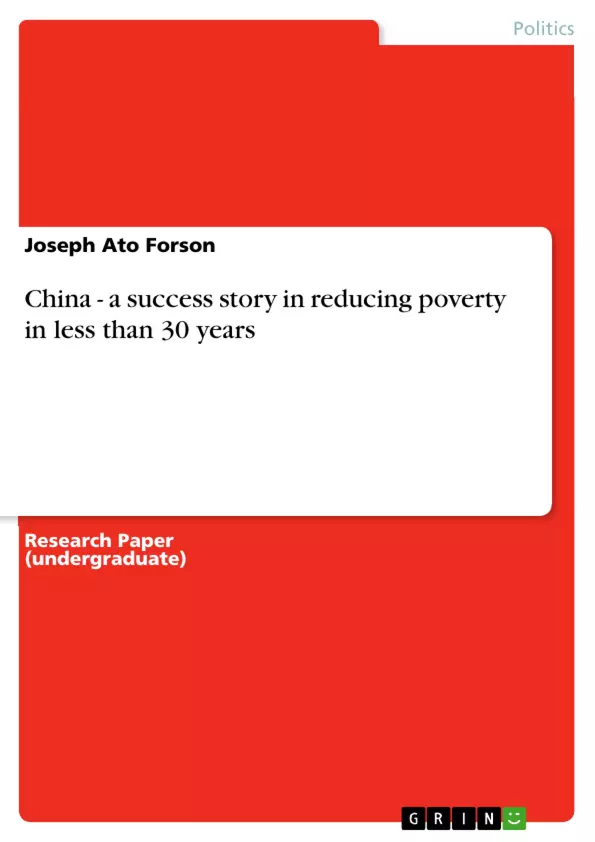This paper takes a critical look at the state of poverty in China and governments efforts at alleviation. Our assessment has been on Chinese Government and other development partners interventions meant to halt poverty. Our analysis indicated that China has indeed succeeded in reducing the number of people in absolute poverty from 250 million to 15 million in less than 30 years, which is very encouraging. But it should be pointed that this has been at the expense of its environment. However, its environmental problems are somewhat a major obstacle. As the average citizen attains a middle income status, their demand for a clean environment coupled with pollution free atmosphere becomes imperative. China should be able to overcome these environmentally related problems as it strives for global recognition.
Inhaltsverzeichnis (Table of Contents)
- Abstract
- List of Tables
- List of Figures
- CHAPTER ONE
- OVERVIEW OF THE STUDY
- Background to the Study
- Scope
- Objectives
- Methodology
- Limitations
- CHAPTER TWO
- POVERTY SITUATION AND ALLEVIATION EFFORTS IN CHINA
- The Poverty Situation in China
- The Quantity and Distribution of the Rural Poor in China
- Poverty Alleviation Efforts in China
- Poverty Alleviation in Rural Areas and Factors behind its Success
- Governments Interventions
- Interventions from Other Agencies
- CHAPTER THREE
- CONCLUSION AND RECOMMENDATIONS
- Conclusion
- Recommendations
- REFERENCE
Zielsetzung und Themenschwerpunkte (Objectives and Key Themes)
This paper analyzes the state of poverty in China and the government's efforts to alleviate it. The primary objective is to examine the effectiveness of interventions by the Chinese government and other development partners in reducing poverty. The paper assesses the successes and challenges associated with these efforts, particularly in relation to the country's environmental impact.- The extent and distribution of poverty in China
- Governmental and non-governmental interventions for poverty alleviation
- The impact of poverty alleviation efforts on the environment
- The balance between economic development and environmental sustainability in China
- The challenges and opportunities facing China in its pursuit of global recognition.
Zusammenfassung der Kapitel (Chapter Summaries)
Chapter One: Overview of the Study
This chapter provides a general introduction to the research, outlining its scope, objectives, methodology, and limitations. It lays the groundwork for the subsequent analysis of China's poverty situation and alleviation efforts.Chapter Two: Poverty Situation and Alleviation Efforts in China
Chapter Two delves into the core of the research, focusing on the extent and distribution of poverty in China, particularly in rural areas. The chapter also examines the various government and non-governmental interventions aimed at poverty alleviation, analyzing their effectiveness and impact on the environment.Schlüsselwörter (Keywords)
The main keywords and focus topics of this paper include poverty alleviation, environmental impact, rural development, government interventions, development partners, China's economic growth, and global recognition. The paper highlights the complexities of balancing economic development with environmental sustainability in China's pursuit of a more prosperous and internationally recognized future.- Quote paper
- Joseph Ato Forson (Author), 2008, China - a success story in reducing poverty in less than 30 years, Munich, GRIN Verlag, https://www.grin.com/document/207762



